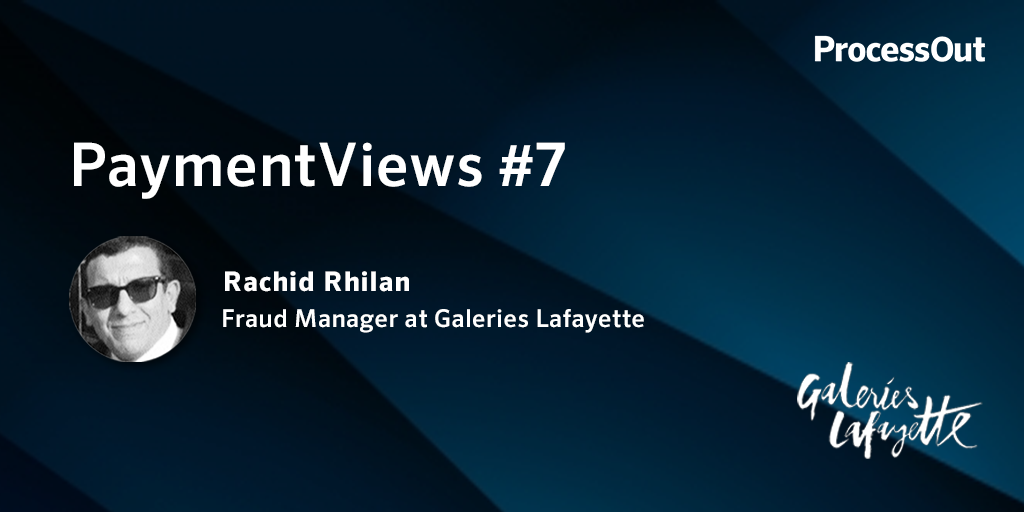PaymentViews #7 — Rachid Rhilan, Fraud Manager at Galeries Lafayette
by Matthieu Couet on
With more than twenty-five years of experience in fraud-fighting in companies such as SFR or Débitel, Rachid Rhian is one of the most experienced french fraud experts. He is now managing fraud and payments at Galeries Lafayettes. Today, Rachid shares with us some feedback and insights about what he learned from its past experiences and how he approaches his current mission at Galeries Lafayette.

Hello Rachid, thanks for taking the time. Can you please introduce yourself and talk a bit about your background?
I have quite an atypical background. Before joining Galeries Lafayette, my expertise was mainly in risk and fraud management. I worked for telecom companies such as Débitel France, a subsidiary of Mercedes, and SFR, for more than 20 years. At this point, I wanted to have a broader vision of risk and decided to join the Economic Warfare School (EFE), in Paris, and got an MBA in risks & cybersecurity there.
I had the opportunity to join Galeries Lafayette to work on risk, fraud, and the payment challenges of the online store. My role has expanded and all things related to payment were pretty new to me. I learned about payments by meeting people, asking lots of questions, and trying to find the best answers.
You worked at SFR in the Risk & Fraud department for 15 years. Can you tell us about that role and maybe share some examples of fraud you came across?
I was managing a team of Fraud Analysts. Our mission was to understand how fraudsters were coming in and to close the doors on them. We were analyzing operational modes ‘post-mortem’ and setting up solutions to secure the user journey. Getting into fraudster’s minds is key and requires a two-dimension analysis:
- Analyzing the ‘primary fraud’: How did they come in? What is their operational mode and process?
- Analyzing the ‘secondary fraud’: Why did they come in? What are the fraudster’s motivations and objectives?
That was kind of the basis of our investigation process.
SIM Swap fraud had probably been one of the biggest challenges for the team. SIM Swap consists of taking control of someone’s device (most of the time, his or her phone), on top of stealing their credit card data. Using social engineering techniques or exploiting the victim’s credibility, fraudsters get access to their text messages and are able to make 3DS payments or to send funds via bank transfers. As SFR, we were not exposed to financial risk but rather to brand risk. In this scheme, we were used as a vector of the fraud. We were fighting international, organized networks of fraudsters, and that was very challenging.
What are your responsibilities as the Payment & Fraud Manager of Galeries Lafayette? Who do you work with internally?
There are two main pillars:
- Risk and fraud management: anticipate different risks and prevent fraud (mainly credit card fraud).
- Payment optimization: drive our payment flows, managing our relations with our partners, assess the optimization opportunities, and drive them forward.
I work with various teams in Galeries Lafayette, from the treasury to the customer support team. At the group level, we often share feedback and best practices between the different branches.
How does Galeries Lafayette approach payments?
Payment optimization is part of the ongoing reflections around the new website that is coming. We want to build the most flexible payment infrastructure and want to go multi-PSP and multi-acquirer in the near future. The PSD2 (reviewed Payment Service Directive), and all its implications is also a big focus. Dynamic 3DS has always been a significant optimization lever. That’s something I have been able to leverage with a high granularity thanks to ProcessOut’s payment monitoring tool. Time will tell whether 3DS2 exemptions become very strategic or not. On top of that, we are always assessing opportunities linked to alternative payment methods (wallets, local schemes).

I used ProcessOut’s Telescope to kick out some topics, such as understanding why some acquirers offer us better performance than others, what data we must send to optimize our providers, and our acceptance rate.
During the lockdown, customer habits changed. What trends did you notice at Galeries Lafayette?
The first thing that we noticed was that the demand for apparel significantly decreased. It’s clearly not on people’s priority list to buy new clothes. In contrast, home products have been very popular. As an e-commerce website, it was definitely good to have a quite diversified offer during those weeks, as product demands shifted very heterogeneously.
Shipping has been very perturbed of course, but customers appeared to be pretty understanding about that. Another interesting trend that I don’t know how to explain so far, is an increased demand from surrounding countries.
We also observed more fraud attempts during lockdown. Uncertainty can drive the opportunity for fraudsters. I also guess that fraudsters had more time to organize themself… but so did we!
Thank you, Rachid!
*****
If you want to know more about how sophisticated businesses deal with payment, read our last interviews of payment leaders:
